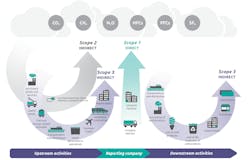A growing awareness of climate change and global warming—followed by increasing demands for action by customers, employees, job candidates and the public—are pushing many process industry businesses and organizations to pledge to meet net-zero GHG emissions targets, and adopt sustainable manufacturing practices.
Of course, these efforts can be greatly aided by common concepts, definitions and language, which can help keep all parties on the same page and maximize what they accomplish.
One of the most comprehensive tools is the three scopes for emissions defined in the greenhouse gas (GHG) protocol developed by the World Resources Institute (WRI) and the World Business Council for Sustainable Development (WBCSD). It classifies a company’s GHG emissions as:
- Scope 1—direct emissions from its owned or controlled sources;
- Scope 2—indirect emissions from the generation of purchased energy; and
- Scope 3—indirect emissions, not included in Scope, that occur in the value chain of the reporting company, including both upstream and downstream emissions (Figure 1).
To put the reasons for sustainability into a larger context, it helps to consider the 17 goals drafted the U.N. Dept. of Economic and Social Affairs and adopted in 2015 by all U.N. member states. The goals are the heart of an agenda for 2030 that provides a shared blueprint for peace and prosperity for people and the planet now and into the future. Each goal has multiple targets and related actions, events, publications. They include:
- End poverty in all its forms everywhere.
- End hunger, achieve food security and improved nutrition, and promote sustainable agriculture.
- Ensure healthy lives and promote well-being for all at all ages.
- Ensure inclusive and equitable quality education and promote lifelong learning opportunities for all
- Achieve gender equality and empower all women and girls
- Ensure availability and sustainable management of water and sanitation for all.
- Ensure access to affordable, reliable, sustainable and modern energy for all.
- Promote sustained, inclusive and sustainable economic growth, full and productive employment, and decent work for all.
- Build resilient infrastructure, promote inclusive and sustainable industrialization and foster innovation.
- Reduce inequality within and among countries.
- Make cities and human settlements inclusive, safe, resilient and sustainable.
- Ensure sustainable consumption and production patterns.
- Take urgent action to combat climate change and its impacts.
- Conserve and sustainably use the oceans, seas and marine resources for sustainable development.
- Protect, restore and promote sustainable use of terrestrial ecosystems, sustainably manage forests, combat desertification, halt and reverse land degradation, and stop biodiversity loss.
- Promote peaceful and inclusive societies for sustainable development, provide access to justice for all, and build effective, accountable and inclusive institutions at all levels.
- Strengthen the means of implementation, and revitalize the global partnership for sustainable development.
Sustainability series 2023
This article is part of the 2023 series on sustainability. Read more here.
About the Author

Leaders relevant to this article:


